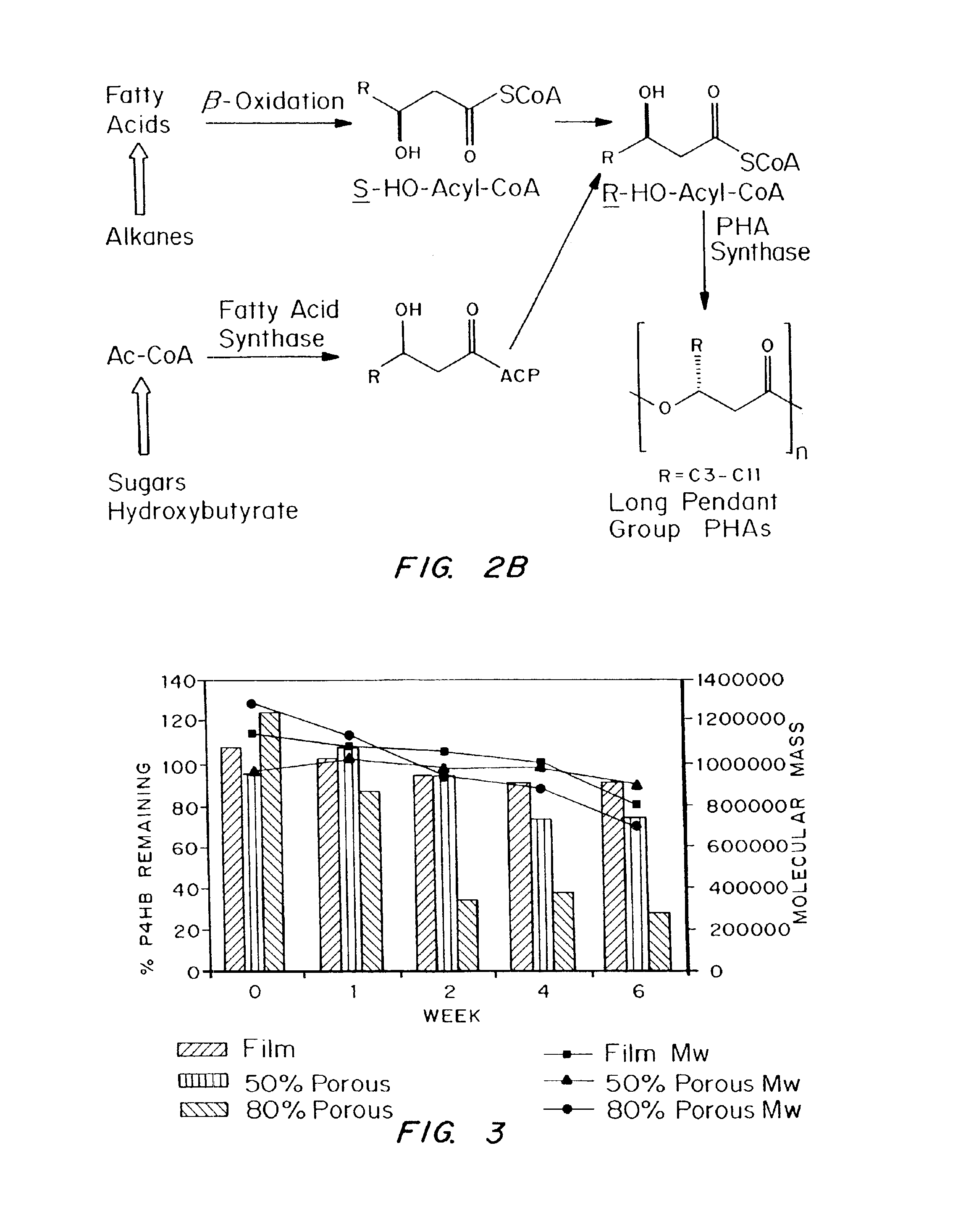Polyhydroxyalkanoate compositions having controlled degradation rates
a technology of polyhydroxyalkanoate and composition, applied in the field of polyhydroxyalkanoate polymers, to achieve the effects of reducing the degradation rate of polyhydroxyalkanoate, reducing the degradation rate, and increasing the porosity or exposed surface area
- Summary
- Abstract
- Description
- Claims
- Application Information
AI Technical Summary
Benefits of technology
Problems solved by technology
Method used
Image
Examples
example 1
Production of P4HB in Recombinant Escherichia coli
E. coli strain MBX1177, a derivative of strain DH5α selected for the ability to grow with 4-hydroxybutyric acid (4HB) as the sole carbon source, was transformed with pFS30, a plasmid containing the genes encoding PHA synthase from Ralstonia eutropha, 4-hydroxybutyryl-CoA transferase from Clostridium kluyveri, and β-lactamase, which confers resistance to ampicillin. The synthase and transferase are under the control of the trc promoter, which is inducible by isopropyl-β-D-thiogalactopyranoside (IPTG) in pFS30. These cells were first grown in 100 ml LB (Luria Broth, Difco, Detroit, Mich.; 25 g / L) plus 100 μg / ml ampicillin overnight in a 250-ml Erlenmeyer flask at 37° C. with shaking at 200 rpm. This entire culture was used as an inoculum for the fermentation carried out in a 7 L vessel. The first stage of the fermentation consisted of growing biomass in 5 L of LB-ampicillin at 37° C. with stirring at 800 rpm and aeration at 1 volumetr...
example 2
Production of Poly(4HB-co-2HB) in Recombinant Escherichia coli
E. coli strains MBX1177 / pFS30 and MBX184 (CGSC6966) / pFS30 were precultured in 300 mL LB-ampicillin in a one-liter Erlenmeyer flask at 30° C. overnight with shaking at 200 rpm. Two 100-mL aliquots of each preculture were centrifuged (2000×g, 10 minutes), and the cells obtained from each of these aliquots were resuspended in 100 mL of a medium containing, per liter: 6.25 g LB powder; 2 g glucose; 50 mmol potassium phosphate (pH 7); 100 μg ampicillin; and 100 μmol IPTG. The medium also contained 2-hydroxybutyric acid (2HB) and 4HB; in one flask the concentrations were 8 g / L 2HB and 2 g / L 4HB, and in the other the concentrations of the two acids were each 5 g / L. Both acids were added to the flasks as the sodium salt; the masses given for the acids do not include the mass of sodium. These four flasks (two flasks for each strain) were incubated at 30° C. for an additional 48 hours with shaking at 200 rpm. The cells were remove...
example 3
Production of Poly(4HB-co-3HB) in Recombinant E. coli
Strain MBX1177 / pFS30 was precultured in 100 ml LB-ampicillin in four separate 250-ml Erlenmeyer flasks at 30° C. overnight with shaking at 200 rpm. An addition of 20 ml of medium was made to each flask such that the total volume contained, per liter: 2.5 g additional LB powder; 4 g 4HB as sodium salt; 4 g glucose; 50 mmol potassium phosphate (pH 7); 100 μg ampicillin; 50 μmol IPTG; and 0.25, 0.5, 0.75, or 1 g 3-hydroxybutyrate (3HB) as sodium salt. The flasks were incubated for an additional 48 hours at 30° C. and 200 rpm. The cells were removed from the medium by centrifugation (2000×g, 10 minutes), washed once with water, centrifuged again, and lyophilized. Gas chromatographic analysis was carried out on the lyophilized cell mass to analyze for polymer content and composition. The standard used to test for 3-hydroxybutyrate units in the polymer was poly(3-hydroxybutyrate). The cellular contents and compositions of the PHAs prod...
PUM
| Property | Measurement | Unit |
|---|---|---|
| tensile strength | aaaaa | aaaaa |
| tensile strength | aaaaa | aaaaa |
| tensile strength | aaaaa | aaaaa |
Abstract
Description
Claims
Application Information
 Login to View More
Login to View More - R&D
- Intellectual Property
- Life Sciences
- Materials
- Tech Scout
- Unparalleled Data Quality
- Higher Quality Content
- 60% Fewer Hallucinations
Browse by: Latest US Patents, China's latest patents, Technical Efficacy Thesaurus, Application Domain, Technology Topic, Popular Technical Reports.
© 2025 PatSnap. All rights reserved.Legal|Privacy policy|Modern Slavery Act Transparency Statement|Sitemap|About US| Contact US: help@patsnap.com


